Editorial of EPW
There is a need to go beyond the immediate tragedy of
Nandigram and examine the underlying process that gives
rise to such episodes. In the neoliberal times that we are
living through, governments, whether at the central or a state
level, are essentially for the markets, by the markets and of
the markets. Indeed, the parliamentary political process is
increasingly governed by the logic of the market. But at a
more basic level, the process of capitalist development, which
is now driven largely by private investment, is creating
progress and wealth at one pole, while at the same time
dragging masses of people – poor and middle peasants,
landless rural workers, urban workers weakened by the
decline of effective trade unions, and non-wage earners in the
informal sector – “through blood and dirt, through misery
and degradation” at the other.
Classically, the “peasant question” has been articulated in
terms of class differentiation of the peasantry, ultimately
tending to polarisation into capitalists and proletarians.
However, the process of industrialisation also demands the
mobilisation of agricultural land that leads to displacement
of peasants, leading to their “proletarianisation” or
“marginalisation” in an urban environment, a process that has
accelerated in India since the 1980s. Of course, before the
reforms and the drive towards free trade in agricultural
commodities initiated at the World Trade Organisation, such
effects were mitigated through state support to agriculture in
various forms. But now the “commodification” of food is at
high tide. The “peasant question” of the 21st century, more
than in the past, thus brings to the fore issues of landlessness,
hunger, “informalisation”, homelessness and environmental
destruction. Millions of people have been victims of displacement
and dislocation, and many more will follow, if the
many proposals on the anvil to set up special economic zones
(SEZs) go ahead in the country.
In West Bengal, to the credit of the Left Front (LF) government,
land reform – implementation of the land ceiling
and the redistribution of land, as also “Operation Barga” –
improved the distribution of income and changed the incentive
structure in favour of those who tilled the land, though
subsequently some land transfers may have been reversed via
the market. But over time there has been the inevitable rising
disproportion between the rural population, land resources
and jobs, what with the failure of rural industry to take off.
The CPI(M) has been rightly quite concerned about the
future of the small and middle peasants, given the decline of
landholding areas and the limits of the diffusion of technical
progress, and with the increase in population density also
about the landless. After all, with the land reform, around 80
per cent of the cultivated land is now with small and middle
peasants, whereas elsewhere, where the implementation of
the land ceiling and redistribution was a failure, this proportion
is less than half that figure. And, post-land reforms, the
Chayanovian tendency of demographic differentiation has
also asserted itself. But will industrialisation in the form of
a “mega-chemical hub” and multi-product SEZ over 10,000
acres of land in Nandigram or elsewhere and other such
projects serve to address the question of alternative livelihood
opportunities? An enormous number of people who are
involved in agriculture and allied activities will be expropriated
and displaced as a result, leading to a further increase
in the huge mass of people in the informal sector, living on
the margins of existence.
Should not the CPI(M) then be thinking and acting at least
along social-democratic lines? In agriculture and allied
activities, the LF government, with the active participation
of the Kisan Sabhas, can help form mutual aid teams in which
households can pool resources (tools, implements, draft power,
occasional labour) but still cultivate the land on an individual
basis. When this is successful, they can then move to the
formation of elementary cooperatives in which land as well
as other resources can be pooled, but individual ownership
rights maintained, and where incomes can be based partly
on property ownership and partly on labour time committed
to cooperative production. In industry, the LF government
should be pursuing more vigorously its policy of industrial
clusters based on specific products/skills of small and
medium units with common infrastructure services that
improve the viability of the units. Here too, cooperative forms
of organisation can be given precedence, with the trade
सीपीएम की क्रांति
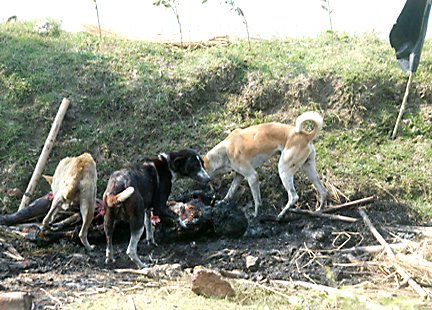
हम एक लोकतंत्र में रह रहे हैं! 14 मार्च को हुई घटना और उसके बाद सीपीएम के बंद के दौरान गायब हुए दो सौ लोगों का अब तक कोई अता-पता नहीं है्. हां। कुछ लाशें हैं जो इलाके में इस हालत में पायी गयी हैं. क्या हम बता सकते हैं कि इन्होंने किस बात की कीमत चुकायी? क्या हम इसको लेकर आश्वस्त रह सकते हं कि हमें भी कभी ऐसी ही कीमत नहीं चुकानी पड़ेगी?
Subscribe to:
Post Comments (Atom)
नंदीग्राम पर नयी फ़िल्म
यह फ़िल्म 14 मार्च की घटनाओं के सूक्ष्म विवरण के साथ आयी है.
देखें : नव उदारवाद का नया चेहरा बजरिये नंदीग्राम
देखें : विकास के नाम पर लोगों के उजड़ने की कहानी
उन्होंने मेरे पिता को टुकडों में काट डाला
देखें : न हन्यते
नंदीग्राम में 100 से ज्यादा लोग मारे गये हैं, 200 अब भी लापता हैं. वहां महिलाओं के साथ सीपीएम के कैडरों ने बलात्कार किया. बच्चों तक को नहीं छोड़ा गया है. सीपीएम की इस क्रूरता और निर्लज्जता का विरोध होना चाहिए. हमें नंदीग्राम, सिंगूर और हर उस जगह के किसानों के आंदोलन का समर्थन करना चाहिए, जो अपनी जमीन बचाने के लिए लड़ाई लड़ रहे हैं. यह दस्तावेज़ी फ़िल्म किसानों के इसी संघर्ष के बारे में है. यह फ़िल्म नंदीग्राम के ताज़ा नरसंहार से पहले बनायी गयी थी.
नंदीग्राम में जनसंहार के बाद के द्श्य
यह फिल्म पुलिस द्वारा नंदीग्राम में बर्बर तरीके से की गयी हत्याओं एवं उनकी भयावहता व बर्बरता के बारे में है. इसके कई दृ़श्य विचलित कर देनेवाले हैं.
नंदीग्राम प्रतिरोध्
नंदीग्राम में सरकारी आतंक
देखें : माकपा की गुंडागर्दी
नंदीग्राम में सीपीएम सरकार की पुलिस ने जो बर्बर कार्रवाई की, वह अब खुल कर सामने आने लगी है. यह फ़िल्म उसी बर्बरता के बारे में है. इसके कई दृश्य आपको विचलित कर सकते हैं. आप इसे तभी देखें जब आप वीभत्स दृश्य देख सकने की क्षमता रखते हों. हम खुद शर्मिंदा हैं कि हमें ऐसे दृश्य आपको दिखाने पड़ रहे हैं, पर ये आज की हकीकत हैं. इनसे कैसे मुंह मोडा़ जा सकता है?

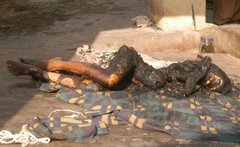
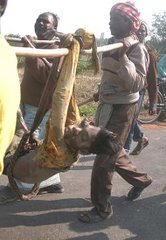
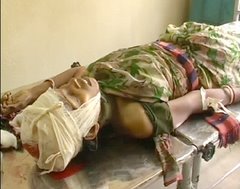

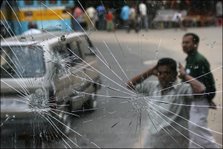
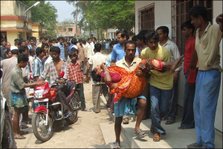

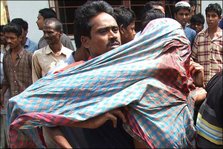


No comments:
Post a Comment